Jamdani: A fabric of then and now
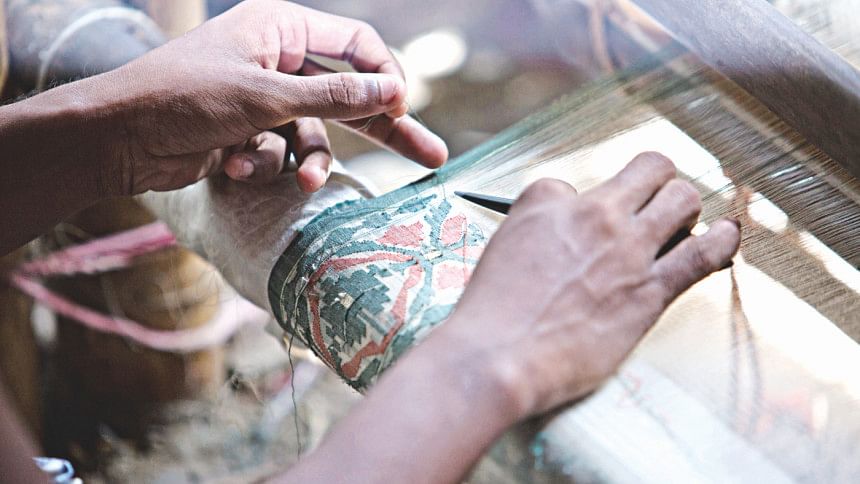
Along the banks of the Sitalakhya river in Narayanganj, some 20 villages in Sonargaon, Rupganj, and Siddhirganj in particular, women villagers starch yarn in lime and toasted rice to make warp yarn—the vertical, lengthwise weaves that make up a fabric. The weft yarn—the horizontal snake-like components of a weave—is likewise starched in cooked rice, dried, and wound around a spindle. The yarn that will make up the motif is left unstarched, three strands of which are spun on the spindle.
The starched warp dries and spins on a cylindrical bamboo frame. It finds itself on a metal grid, grouped into individual rolls, and is threaded through blind-like wooden frames. Then it goes on a walk, as two women attach the yarn to bamboo sticks stationed at intervals on the ground. It takes them hours to thread each warp yarn through a fine, bamboo reed comb, which affects the fineness of what will eventually become the fabric. Placed side-by-side to be pulled by a lever (a wooden pole) and formed into a sheet, the yarns are then threaded through wooden shafts (heddles). In time, the wefts will snake their way through the spaces left behind by these heddles across the warp. Finally, wrapped around that wooden pole, the warp finds itself on the weaver's pit loom.
Thus begins the journey of the Jamdani—one of ancient Bengal's finest cotton muslins, a remnant of the region's Mughal rule. "The indigenous weavers of India and weavers brought in from Persia—created a new fabric called Jamdani," explains Ruby Ghuznavi, executive member of the National Crafts Council of Bangladesh (NCCB), and a member of the research, documentation, production, and exhibition committee of the recently held Jamdani Festival 2019, jointly organised by the NCCB and the Bengal Foundation.
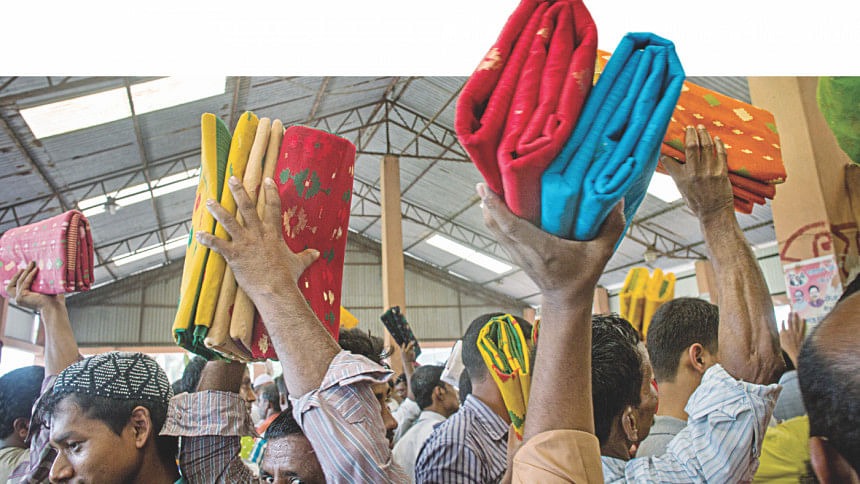
The weavers were brought in by Muhammad bin Tughluq, the Sultan of Delhi in the 14th century, writer and editor Farida Noireet writes in her paper "Sonargaon, the birthplace of Jamdani". The temperature and humidity of the climate, the soil ecology, and the minerals contained in the Sitalakhya's waters made Sonargaon uniquely suited for the production of cotton, particularly Jamdani. By the 16th century, the patronage of the Mughal emperors had cultivated the art into a thriving fashion trend for both men and women in the Mughal Empire. Positioned as it was at the junction between Bengal and the Far and the Middle East, and the rivers of Sitalakhya, Meghna, and Brahmaputra, Sonargaon (then capital of Mughal Bengal) flourished as a hub of commercial activity until the 17th century; and so Jamdani travelled and became popular also among the courtiers across Britain and Europe.
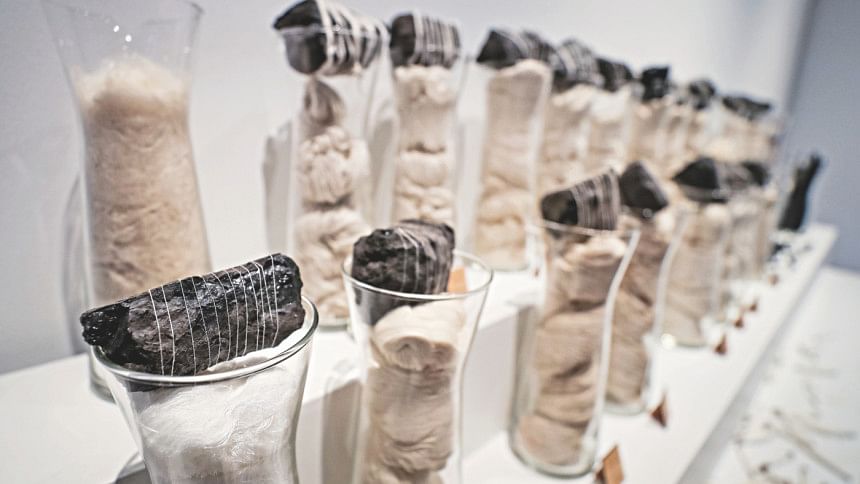
The trade's decline began from the 18th century, writes human rights activist Dr Hameeda Hossain, author of Company Weavers of Bengal: Textile Production for the East India Company 1750-1813 and Working Conditions of the Company Weavers in Dhaka Arangs. Dr Hossain explains how the East India Company began exercising more and more control over textile production in the region as it grew into a monopsony, particularly from 1753, pushed by increasing competition from other European companies and private merchants. They exerted operational control—gumashtas (agents employed by the buyers) replaced dalals to monitor production; financial control—higher advances indebted weavers to the Company; and legal and bureaucratic control—regulations for weavers curbed their interaction with other weavers. The artisans, as a result, grew increasingly discouraged from taking orders for the fabric.
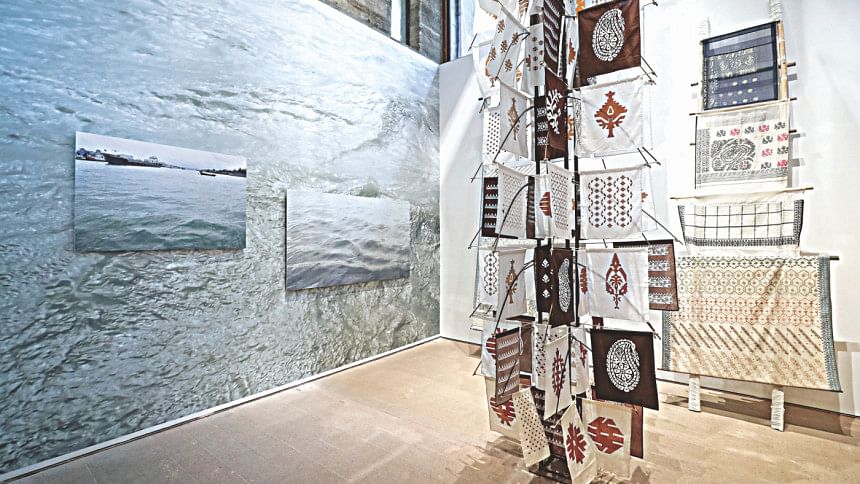
Meanwhile, floods and famine in 1770 destroyed the region's ability to produce cotton as more and more land turned to producing rice. Around the same time, England cut down on its imports and began exporting more of its industrially manufactured goods to colonies. Yet the Jamdani trade survived through private merchants as the East India Company closed its Dhaka factory after being subsumed by the Crown in 1833. Jamdani saris became a favourite among middle and upper-class Bengali women, and became also a symbol of protest, as a hand-spun fabric, following Mahatma Gandhi's rejection of industrially manufactured fabric in his Satyagraha movement. The wars of Bengal brought forth a fresh wave of threats to the trade—the Partition of 1947 saw a loss of rich Hindu clients when they left West Bengal, and both the Partition and the Liberation War of 1971 destroyed raw materials and weavers' homes and looms.
***
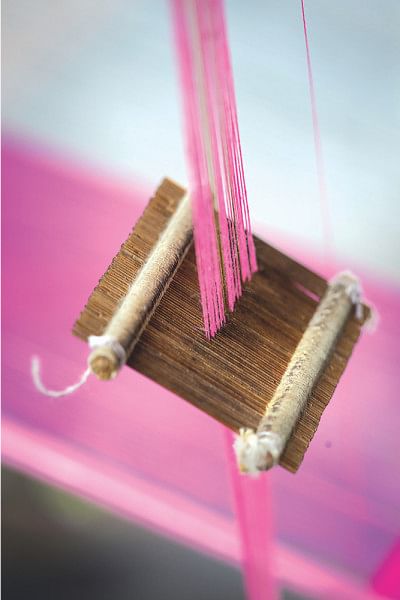
Back on the loom—a primitive apparatus fashioned out of wood and bamboo—two weavers sit and work in tandem, the master weaver on the right, on the left, the apprentice awaiting his instructions, his buli. Together, they place eight to 18 inches of yarn into the warp to create a motif. This motif yarn will be thicker than the warp and weft in order to stand out.
With each row of the weave completed, a metal spindle will travel across the warp, carrying with it the weft. The whole time, the master weaver will control a foot pedal to move the double reeds on the loom up and down as needed. They repeat the act on each row, sprinkling and rubbing starch on every nine inches of the yarn, until a finished fabric emerges.
It was here that Md Jamal Hossain, a master weaver from Sonargaon, began learning the process from his uncle 23 years ago at the age of 14. It was either this or studying in a classroom, which he hated. He sat at the loom from 6 am in the morning to 10pm at night. The joints in his fingers, arms, knees, and feet throbbed. For the first few years there was no electricity, and so working in the dark with a lantern hurt his eyes. "As the shagrid (apprentice) I had to be the first one to set up at work. I'd wake up at dawn, take a quick plunge in the khaal for a bath, and come to the workstation with soap suds still clinging to my hair," he recalls.
Today, Jamal Hossain is the proprietor of the Phakhi Jamdani weaving factory in Sonargaon, where he works with 50 other weavers on 25 looms. They used to weave around 25 saris per week, with a thread count of 200 to 300. The fabric was coarse, the designs less intricate. Yet the work still requires him, and other weavers in his area, to work from early morning until late into the night. "I hardly have any idea how my family are doing back at home," Hossain confesses, although more and more women are now becoming weavers of the fabric.
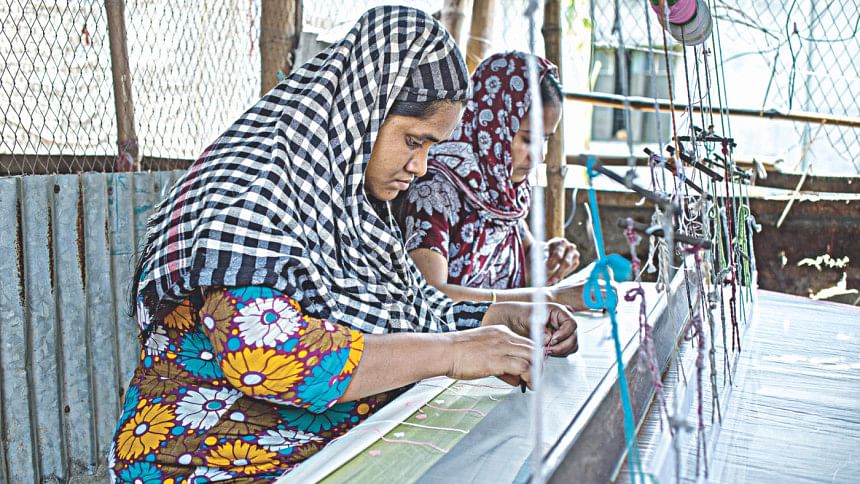
Working with the Jamdani festival required around 50 of such weavers to attempt to replicate the original Mughal fabrics. They managed to reach 2,400 thread counts over the past two years—a near-miraculous task for craftsmen who had never seen the products before. Each inch weaved took them almost eight hours to complete; it was excruciating for the limbs and the eyes. Hossain recalls, "We weaved samples for weeks and threw each away. 20, 25 weavers rejected one particularly difficult design called the 'Mehraab' once presented to a Mughal princess. They said it couldn't be Jamdani, it was so difficult to make. We worked at the loom, got up and walked away in frustration, came back to try again until we succeeded." The finesse achieved from the practice now allows them to charge much higher prices for their products.
Weaving these saris, however, takes them six to eight months. But the weavers need to get paid on a weekly basis. "A fine Jamdani sari costs around Tk 100,000 today. If I pay each of my weavers Tk 2,000 per month, I have to pay Tk 50,000 in wages. Then I have travel expenses, expenditures for my parents, my wife and children. At the end of the month, I don't even have enough money left to repair the broken chowki on which I sleep at home," shares Hossain.
This begs the question: How many people can afford saris at such prices? How can the artform and its artists be sustained?
Textile and crafts design giant Chandra Shekhar Shaha explains: "Suppose these saris cost between Tk 10,000 to 150,000, and another separate range costs up to Tk 1,000,000. This automatically creates a classification of patrons at each range. Even the Tk 10,000-25,000 range can secure years' worth of earnings for a weaver if each client has just one Jamdani in their wardrobe. If even a quarter of one percent of our population sought to buy Jamdani, that's almost 4.5 lakh Jamdani pieces. So, what we need is awareness—through media campaigns, a handful of fashion shows per year, donning the fabric and presenting it as gifts when travelling abroad—to preserve this legacy."
Yet he highlights other challenges. "The weaving of the weft in Jamdani requires immense mental focus. It's all mathematical; the slightest miscalculation can distort the entire make-up of the fabric. But many power looms have moved into the regions where Jamdani is weaved, and the noise pollution from these machines disrupts the Jamdani weavers' concentration when they orate their designs."
In an effort to address these issues, the NCCB plans to provide weavers with quality tools and materials, such as by setting up yarn banks, share executive members Ruby Ghuznavi and Chandra Shekhar Shaha. Through dialogues with the government, they're aiming to establish pension plans for aged weavers, and set up schools both to educate weavers' children and to help reduce child labour at the looms. There are other plans to collect, document, and publish wider collections of ancient Jamdanis from around the world to nurture further research. Having recently helped Sonargaon win the title of a World Craft City as the birthplace of Jamdani, they are hopeful that the region will now attract more funding, exposure, and flurry of creative activity.
***
These efforts highlight the value of Jamdani as a heritage fabric for Bengal. Having researched on the fabric for decades, Ruby Ghuznavi draws the distinction, "With every other fabric, the designs were either printed or embroidered on top. Jamdani was unique because the designs were woven into the fabric."
Shaha, who curated the Jamdani exhibition as part of the festival, points out other unique characteristics as we take a stroll through the display at Bengal Shilpalay in Dhanmondi.
He steps behind a white Jamdani sari hung a little distance from a white wall on the upper storey of the gallery. As sunlight wafts its way through the fabric, its designs cast a shadow of geometric patterns on the wall, mesmerising in their intricacy. "Jamdani motifs always have breathing spaces within them," he highlights.
"The other element is the 'float'," he says of the fine lines jutting out of the larger floral patterns, before pointing out small meena butis sprinkled over flowers and leaves, each pierced with countless tiny holes.
"Transparency of the sari's body and density of the threads making up the motifs, each ornamentation placed at a proportional distance from each other, these components strike a beautiful balance in the Jamdani," explains Shaha.
These designs have been passed down verbally through generations of weavers, but their origins lie in reflecting the local flora and fauna where they were first weaved, as well as the architecture surrounding their first wearers. Butis—individual floral motifs—dot the length of the fabric. The par—the border—contains another different set of patterns. The terchi winds diagonally through the fabric and the jaal—a net-like design—often blankets the entire length. Among the more intricate motifs are the bagnoli, symbolising a tiger's paw, and the kalka, which came to be known as the paisley, christening a town with its name in Scotland. An image of the jasmine, apparently a favourite from the time, reappears often among the older designs.
Walking to an old Jamdani scarf on display, Shaha points out the reflection of Mughal ornamentation and architecture in the designs—the marble throne, the archways. Other samples depict angur lota—grapevines—and the corinthian leaf. On the other side of the room, a plain white Jamdani with a thin red border reveals, potentially, the identity of its wearer—the plain design indicating that she was a rather aged woman, but the red border implying that she was most likely not a widow.
Over time, these ancient motifs have become simplified, losing touch with the time in which the fabric first flourished. But even today, around 2,000 Jamdani pieces get produced each week in the Narayanganj region. Around 15,000 people from 3,000 families were employed in the trade as of 2013, as per figures provided by Farida Noireet. These pieces mark Jamdani as more than just a relic of the Mughal age. In each individual thread and motif of today's Jamdanis are bottled the artistry of countless weavers and their tired, paining limbs, and ancestral memories of designs passed from father to son, uncle to nephew and now sisters and wives. The fabric symbolises a craft that weaves history—personal, national, political, cross-continental—and the present into a translucent, kaleidoscopic whole. Yet it retains its humility.
"From trying to revive the original Jamdani we realised," shares master weaver Jamal, "that we can help people rediscover what courtiers wore 200-300 years ago and bring back that craft, only if we are given some financial assistance and access to quality materials. At the end of the day, we want to help make Jamdani a world famous symbol of Bengali Muslim heritage. But we also want to afford basic sustenance."
Sarah Anjum Bari can be reached at [email protected]

 For all latest news, follow The Daily Star's Google News channel.
For all latest news, follow The Daily Star's Google News channel. 



Comments